Optimization of lightweight foamed concrete using fly ash based on mechanical properties

Since weight loss in structures has reduced the effect of earthquake; many researchers have focused on the use of foamed concrete. Using foamed concrete with fly ash could be used as a great solution to reduce carbon footprint of concrete. The main objective of this research is to study the mechanical properties of concrete by using foam and fly ash, meanwhile the effective parameters on its strength, density and durability. Therefore, the survey investigates the characteristics of foamed concrete by means of laboratory sampling and trying to increase concrete’s strength, while reducing the weight of concrete. First, to obtain the optimal foam percentage, various percentages of foam were replaced with concrete mortar and tested under a compressive strength test. Then the samples were tested with various percentages of fly ash to evaluate their strength. The results demonstrate that the concrete with a mix design of 10% foam and 15% fly ash has reached the maximum value of compressive strength on 28 days of curing, equivalent to 24.7 MPa. Furthermore, the highest value of splitting tensile strength of concrete with 10% foam, 15% and 5% fly ash is about 3.3 MPa. At the end of this study, the optimum percentage of fly ash was replaced with super fly ash to compare their results.
This is a preview of subscription content, log in via an institution to check access.
Access this article
Subscribe and save
Springer+ Basic
€32.70 /Month
- Get 10 units per month
- Download Article/Chapter or eBook
- 1 Unit = 1 Article or 1 Chapter
- Cancel anytime
Buy Now
Price includes VAT (France)
Instant access to the full article PDF.
Rent this article via DeepDyve
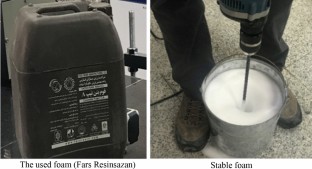

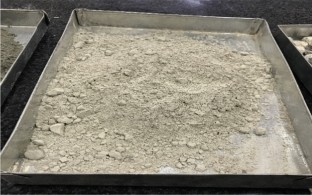
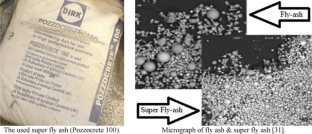

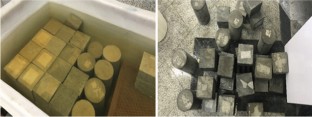
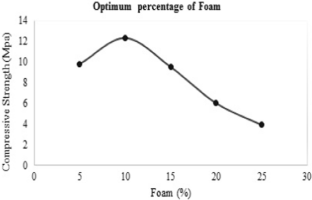
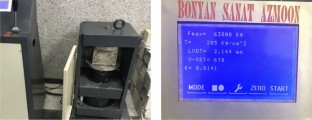
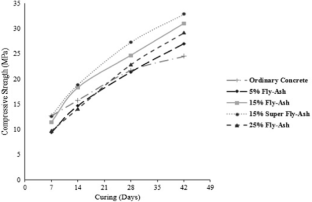
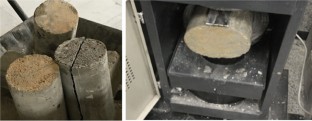
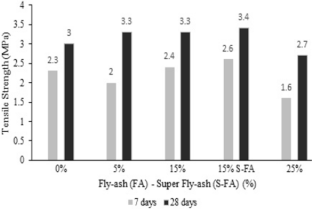
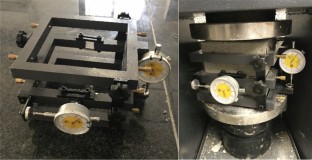
Similar content being viewed by others
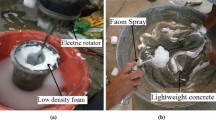
Effect of ingredients ratios on the strength of foamed concrete: an experimental study
Article 12 January 2023

Investigation on Strength Characteristics of Silica Fume Incorporated Foamed Concrete
Chapter © 2020

Light Weight Foamed Concrete as a Substitute for Bricks in Framed Structure
Chapter © 2020
Explore related subjects
Availability of data and material
The data of this research are available.
Code availability
There is no code in this study.
Notes
Split tensile strength test method consists of applying a diametrical compressive force along the length of a cylindrical concrete specimen within a prescribed range until failure occurs. This loading induces tensile stresses on the plane containing the applied load and relatively high compressive stresses in the area immediately around the applied load.
References
- Moon AS, Varghese V, Waghmare SS (2015) Foam concrete as a green building material. Int J Res Emerg Sci Technol 2(9):25–32 Google Scholar
- Jalal M, Tanveer A, Jagdeesh K, Ahmed F (2017) Foam concrete. Inter J Civ Eng Res 8(1):1–14 Google Scholar
- Sharma AS, Suhil G, Visali L (2017) Influence of foam densities in cellular lightweight concrete. Int J Res Appl Sci Eng Technol 5(4):1078–1089 ArticleGoogle Scholar
- Christy CF, Tensing D (2011) Greener building material with fly ash. Asian J Civ Eng 12(1):87–105 Google Scholar
- Decky M, Drusa M, Zgutova K, Blasko M, Hajek M, Scherfel W (2016) Foam concrete as new material in road constructions. Proc Eng 161(1):428–433. https://doi.org/10.1016/j.proeng.2016.08.585ArticleGoogle Scholar
- Rai A, Kumar M (2017) Experimental study on compressive and split tensile strength of foamed concrete using stone dust. Int Res J Eng Technol (IRJET) 4(5):1377–1382 Google Scholar
- Kurweti A, Chandrakar R (2017) Specification and quality control of light weight foam concrete. Int J Eng Dev Res (ijedr) 5(2):1932–1938 Google Scholar
- Varghese Sh, Ashok AM, Joseph AK, Swathylekshmi OVA (2017) Study on properties of foamed concrete with natural and synthetic foaming agent. Int Res J Eng Technol (IRJET) 4(3):2009–2011 Google Scholar
- Abdullah AB, Kamarudin H, Bnhussain M, Nizar Kh, Zarina Y, Razak AR (2012) Fly ash-based geopolymer lightweight concrete using foaming agent. Int J Mol Sci 13(6):7186–7198. https://doi.org/10.3390/ijms13067186ArticleGoogle Scholar
- Namsone E, Sahmenkoa G, Korjakins A (2017) Durability properties of high performance foamed concrete. Proc Eng 172:760–767. https://doi.org/10.1016/j.proeng.2017.02.120ArticleGoogle Scholar
- Karthikeyan B, Selvaraj R, Saravanan S (2015) Mechanical properties of foam concrete. Int J Earth Sci Eng 8(2):115–119 Google Scholar
- Paliwal G, Maru S (2017) Effect of fly ash and plastic waste on mechanical and durability properties of concrete. Adv Conc Cons 5(6):575–586. https://doi.org/10.12989/acc.2017.5.6.575ArticleGoogle Scholar
- Kanaka K, Ravi B, Krishna AV (2017) Performance of hardened properties of light weight aggregate (pumice) by using M25 grade concrete. Int J Civ Eng 4(5):103–111. https://doi.org/10.14445/23488352/IJCE-V4I5P119ArticleGoogle Scholar
- Norshahrizan N, Mohd Mustafa AB, Mohd Tahir MF, Andrei VS, Kamarudin H (2016) Utilization of fly ash waste as construction material. Int J Constr Sci 7(1):161–166 Google Scholar
- Bediako M, Amankwah EO (2015) Analysis of chemical composition of Portland cement in Ghana: A key to understand the behavior of cement. Hindawi Pub. Adv Mater Sci Eng. https://doi.org/10.1155/2015/349401ArticleGoogle Scholar
- ACI 318. Building Code Requirements for Structural Concrete (2011) American Concrete Institute, Farmington Hills, MI
- Jinyan Sh, Yuanchun L, Huijie X, Osman G, Yiming P, Qiang Y, Julong G (2022) The roles of cenosphere in ultra-lightweight foamed geopolymer concrete (UFGC). J Clean Prod 48(9):12884–12896. https://doi.org/10.1016/j.ceramint.2022.01.161ArticleGoogle Scholar
- ASTM C150. Standard Specification for Portland cement (2016) ASTM International, West Conshohocken, PA, USA
- Iranian National Standard No. 302, 3rd. Revision. Concrete Aggregates-Specifications (2015) Iranian National Standardization Organization, Tehran, Iran
- ASTM C33. Standard Specification for Concrete Aggregates (2018) ASTM International, West Conshohocken, PA, USA
- Tanyildizi H, Coskun A (2008) Performance of lightweight concrete with silica fume after high temperature. Constr Build Mater 22(10):2124–2129. https://doi.org/10.1016/j.conbuildmat.2007.07.017ArticleGoogle Scholar
- Lei W, Fanxing G, Huamei Y, Yan W, Shengwen T (2021) Comparison of fly ash, PVA fiber, MGO and shrinkage-reducing admixture on the frost resistance of face slab concrete via pore structural and fractal analysis. World Sci 29(2):1–18. https://doi.org/10.1142/S0218348X21400028ArticleGoogle Scholar
- ASTM C-618. Standard specification for coal fly ash and raw or calcined natural Pozzolan for use in concrete (2005) American Society for Testing and Materials, USA
- Wilińska I, Pacewska B (2018) Influence of selected activating methods on hydration processes of mixtures containing high and very high amount of fly ash: a review. J Therm Anal Calorim 133(1):823–843. https://doi.org/10.1007/s10973-017-6915-yArticleGoogle Scholar
- Hashmi A, Shariq M, Baqi A, Haq M (2020) Optimization of fly ash concrete mix – a solution for sustainable development. Mater Today 26(2):3250–3256 Google Scholar
- Sunil BM, Manjunatha LS, Ravib L, Yaragal CY (2015) Potential use of mine tailings and fly ash in concrete. Adv Concr Constr 3(1):55–69. https://doi.org/10.12989/acc.2015.3.1.055ArticleGoogle Scholar
- Golewski GL (2019) The influence of micro crack width on the mechanical parameters in concrete with the addition of fly ash: consideration of technological and ecological benefits. Constr Build Mater 197:849–861. https://doi.org/10.1016/j.conbuildmat.2018.08.157ArticleGoogle Scholar
- Gökçe HS, Hatungimana D, Ramyar K (2019) Effect of fly ash and silica fume on hardened properties of foam concrete. Constr Build Mater 194(1):1–11. https://doi.org/10.1016/j.conbuildmat.2018.11.036ArticleGoogle Scholar
- Hashmi A, Shariq M, Baqi A (2020) Flexural performance of high volume fly ash reinforced concrete beams and slabs. Structures 25:868–880. https://doi.org/10.1016/j.istruc.2020.03.071ArticleGoogle Scholar
- Feng J, Lei Y, Yong L, Yang L, Guodong M (2016) Influence of super-fine fly ash on the properties of concrete under steam curing condition. In: 2nd International Conference on Machinery, Materials Engineering, Chemical Engineering and Biotechnology. pp 113–116. https://doi.org/10.2991/mmeceb-15.2016.24
- Karthik H, Russell L, Michael DA, Surali G, Olga P (2003) Properties of concrete containing ultra-fine fly ash. ACI Mater J 100:426 Google Scholar
- Kucche K, Jamkar S, Sadgir P (2015) Quality of water for making concrete: a review of literature. Int J Sci Res Publ 5(1):1–10 Google Scholar
- Yaghmaei Poudeh A, Dehghanbanadaki A, Golpazir I (2022) Reuse of elevator wire rope waste to improve the tensile strength of plain concrete. Innov Infrastruct Solut 7:70. https://doi.org/10.1007/s41062-021-00627-5ArticleGoogle Scholar
- Chunduri VVH, Khed VC, Adamu M et al (2022) Investigating properties of concrete containing cationic bitumen emulsion. Innov Infrastruct Solut 7:218. https://doi.org/10.1007/s41062-022-00816-wArticleGoogle Scholar
- ASTM C 496/C 496M-04. Standard Test Method for Splitting Tensile Strength of Cylindrical Concrete Specimens (2004) American Standard Test Method, West Conshohocken, Penn, USA
Funding
This research was supported by Concrete and Asphalt Research Center of the Damavand Branch of Islamic Azad University.
Author information
Authors and Affiliations
- Department of Civil Engineering, Roudehen Branch, Islamic Azad University, Roudehen, Iran Seyednavid Hashemmoniri
- Department of Civil Engineering, Pardis Branch, Islamic Azad University, Pardis, Iran Amirabbas Fatemi
- Seyednavid Hashemmoniri














